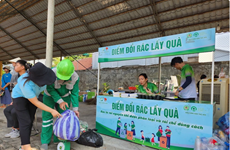Salt water intrusion threatens rice crops in Mekong Delta
Many coastal areas in the Mekong Delta are experiencing saline intrusion, threatening thousands of hectares of rice crops.
Many coastal areas in the Mekong Delta are experiencing saline intrusion, threatening thousands of hectares of rice crops.
In Soc Trang province, saline intrusion has occurred most severely in Long Phu district's Long Phu, Tan Hung and Tan Thanh communes and Long Phu town. Many rice plants that are blooming are facing a severe shortage of water, Sai Gon Giai Phong (Liberated Sai Gon) newspaper has reported.
Farmer Lam Chien in Long Phu commune's Nuoc Man 2 hamlet said over the past two weeks the level of big canals has been very low while ditches in rice fields have nearly dried up. Farmers have been unable to take irrigation water into their rice fields.
"If this situation lasts for more than two weeks, the risk of losing rice will be unavoidable," he said.
Lam Van Vu, deputy head of the Long Phu district Agriculture and Rural Development Bureau, said this year's saline intrusion had occurred a month earlier compared to normal years.
District authorities have prepared measures to maintain fresh water, but canals are silted up and cannot store water, he said.
Last year, farmers had a bumper harvest for the spring-summer rice crop and earned high profits.
As a result, they decided to plant more spring-summer rice this year. Although the district targeted growing 7,000ha of spring-summer rice, farmers have sowed more than 13,000ha.
This expansion of rice cultivation, along with fresh water shortage and early salinity intrusion, have worsened the shortage of irrigation water, Vu said.
In Tien Giang province, salinity intrusion appeared 20 days early compared to last year, causing a shortage of fresh water for nearly 30,000ha of rice in Go Cong Dong, Go Cong Tay and Cho Gao districts.
Nguyen Thien Phap, head of the Tien Giang Sub-department of Irrigation, said the province will try to protect thousands of hectares of rice in Go Cong fresh water zone.
Under the province's plan, farmers will begin harvesting rice in the middle of this month. Local authorities have encouraged farmers to complete the harvest within two weeks.
The sub-department is monitoring the salt content of water to have prompt information for farmers, Phap said.
If the salt content of the water at the Xuan Hoa sluice gate, which receives fresh water for the Go Cong fresh water zone, exceeds 0.2 percent in the next few days, Tien Giang will close the sluice gate and pump fresh water to rescue the rice.
Tien Giang also plans to invest 14 billion VND (660,000 USD) to upgrade water pipes transporting fresh water to Tan Phu Dong island district. This will serve 40,000 people.
In Tra Vinh province, a salt water concentration of 0.4 percent has entered 50 km inland, according to the provincial Centre for Hydro-Meteorological Forecasting.
The salt content of the water of the Hau River in Tra Vinh's Tieu Can district has reached 1 percent compared to 0.77 percent in the same period last year. Tra Vinh has closed all saline-water prevention sluice gates.
Tran Quang Cui, Deputy Director of Kien Giang province's Department of Agriculture and Rural Development, said the province had harvested about 110,000 ha of winter-spring rice and was speeding up harvesting the remaining 200,000ha by the end of this month to avoid saline intrusion.
About 65,000 ha of farmland in U Minh Thuong, Vinh Thuan, An Bien and An Minh districts have been affected by saline water.
To avoid losses, rice farmers in the districts have been encouraged to switch to breeding shrimp and plant rice in June when the rainy season comes, he said.-VNA
In Soc Trang province, saline intrusion has occurred most severely in Long Phu district's Long Phu, Tan Hung and Tan Thanh communes and Long Phu town. Many rice plants that are blooming are facing a severe shortage of water, Sai Gon Giai Phong (Liberated Sai Gon) newspaper has reported.
Farmer Lam Chien in Long Phu commune's Nuoc Man 2 hamlet said over the past two weeks the level of big canals has been very low while ditches in rice fields have nearly dried up. Farmers have been unable to take irrigation water into their rice fields.
"If this situation lasts for more than two weeks, the risk of losing rice will be unavoidable," he said.
Lam Van Vu, deputy head of the Long Phu district Agriculture and Rural Development Bureau, said this year's saline intrusion had occurred a month earlier compared to normal years.
District authorities have prepared measures to maintain fresh water, but canals are silted up and cannot store water, he said.
Last year, farmers had a bumper harvest for the spring-summer rice crop and earned high profits.
As a result, they decided to plant more spring-summer rice this year. Although the district targeted growing 7,000ha of spring-summer rice, farmers have sowed more than 13,000ha.
This expansion of rice cultivation, along with fresh water shortage and early salinity intrusion, have worsened the shortage of irrigation water, Vu said.
In Tien Giang province, salinity intrusion appeared 20 days early compared to last year, causing a shortage of fresh water for nearly 30,000ha of rice in Go Cong Dong, Go Cong Tay and Cho Gao districts.
Nguyen Thien Phap, head of the Tien Giang Sub-department of Irrigation, said the province will try to protect thousands of hectares of rice in Go Cong fresh water zone.
Under the province's plan, farmers will begin harvesting rice in the middle of this month. Local authorities have encouraged farmers to complete the harvest within two weeks.
The sub-department is monitoring the salt content of water to have prompt information for farmers, Phap said.
If the salt content of the water at the Xuan Hoa sluice gate, which receives fresh water for the Go Cong fresh water zone, exceeds 0.2 percent in the next few days, Tien Giang will close the sluice gate and pump fresh water to rescue the rice.
Tien Giang also plans to invest 14 billion VND (660,000 USD) to upgrade water pipes transporting fresh water to Tan Phu Dong island district. This will serve 40,000 people.
In Tra Vinh province, a salt water concentration of 0.4 percent has entered 50 km inland, according to the provincial Centre for Hydro-Meteorological Forecasting.
The salt content of the water of the Hau River in Tra Vinh's Tieu Can district has reached 1 percent compared to 0.77 percent in the same period last year. Tra Vinh has closed all saline-water prevention sluice gates.
Tran Quang Cui, Deputy Director of Kien Giang province's Department of Agriculture and Rural Development, said the province had harvested about 110,000 ha of winter-spring rice and was speeding up harvesting the remaining 200,000ha by the end of this month to avoid saline intrusion.
About 65,000 ha of farmland in U Minh Thuong, Vinh Thuan, An Bien and An Minh districts have been affected by saline water.
To avoid losses, rice farmers in the districts have been encouraged to switch to breeding shrimp and plant rice in June when the rainy season comes, he said.-VNA













